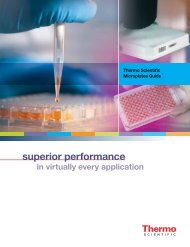PeloBiotech
Create successful ePaper yourself
Turn your PDF publications into a flip-book with our unique Google optimized e-Paper software.
www.pelobiotech.com<br />
Eyes<br />
We isolate retinal pigment cells, endothelial cells, cryopreserved<br />
CnCePc, RbCEpCs, keratinocytes, meshwork cells, retinal<br />
astrocytes, and various immortalized pericytes from the eyes.<br />
These samples are sourced from various species and various<br />
regions and vessels of the eye. Retinal pigment epithelial (RPE)<br />
cells play a crucial role in maintaining retinal homeostasis and<br />
visual function. They have been extensively studied for their<br />
involvement in retinal diseases, such as age-related macular<br />
degeneration (AMD), and have been used to model retinal<br />
pathologies in vitro. RPE cells have been shown to be involved in<br />
the regulation of the blood-retinal barrier (BRB) and have been<br />
used to establish cell lines and study transport functions across the<br />
inner BRB. Additionally, RPE cells have been implicated in the<br />
transfer of melanosomes to keratinocytes, contributing to skin<br />
pigmentation and melanosome distribution. Furthermore, RPE<br />
cells have been studied for their involvement in the pathogenesis<br />
of diabetic retinopathy and have been used to establish a human<br />
retinal pericyte line, providing a novel tool for the study of diabetic<br />
retinopathy.<br />
Endothelial cells have been extensively studied for their role in angiogenesis, blood-brain barrier (BBB) function, and<br />
the regulation of vascular permeability. They have been used to establish cell lines and study the formation and disruption<br />
of the BBB, providing insights into CNS homeostasis and the pathogenesis of neurological disorders. Endothelial cells have<br />
been implicated in the regulation of the blood-nerve barrier (BNB) and have been used to establish a new in vitro BNB<br />
model, contributing to the study of peripheral neuropathy and peripheral nerve function. Cryopreserved corneal<br />
endothelial precursor cells (CnCePc) and retinal endothelial cells (RbCEpCs) have been studied for their potential in corneal<br />
and retinal tissue engineering and regenerative medicine. They have been used to establish cell lines and study the<br />
expression of wound-healing-related genes in primary human keratinocytes from burn patients, providing insights into<br />
the potential therapeutic applications of these cells in wound healing and tissue regeneration. Keratinocytes have been<br />
extensively studied for their role in skin pigmentation, wound healing, and skin regenerative applications.<br />
They have been used to study melanosome transfer, phagocytic activity, and the distribution pattern of melanosomes,<br />
shedding light on their role in skin pigmentation and melanosome transfer to keratinocytes. Keratinocytes have been used<br />
to establish a new immortalized human lung pericyte cell line, providing a promising tool for human lung pericyte studies<br />
and contributing to the study of lung pericyte functions in vitro. Meshwork cells, also known as trabecular meshwork,<br />
have been studied for their involvement in glaucoma and aqueous humor outflow regulation. They have been used to<br />
study the regulation of extracellular-superoxide dismutase and have been implicated in the regulation of L-arginine<br />
transport in retinal pericytes, providing insights into their role in retinal pericyte function and oxidative stress regulation.<br />
Retinal astrocytes have been studied for their involvement in neuroinflammation and the blood-brain barrier (BBB).<br />
They have been used to identify distinct contributions of astrocytes and pericytes to neuroinflammation and have been<br />
implicated in the regulation of the blood-brain barrier (BBB) and the maintenance of CNS homeostasis. Immortalized<br />
pericytes have been extensively studied for their involvement in the blood-brain barrier (BBB), retinal pericyte function,<br />
and the regulation of L-arginine transport. They have been used to study the expression of rat ABCG2 on the luminal side<br />
of brain capillaries and have been implicated in the regulation of L-arginine transport in retinal pericytes, providing insights<br />
into their role in retinal pericyte function and the blood-brain barrier (BBB).<br />
Lymphatic system<br />
We provide fibroblasts and endothelial cells from various vessels of the lymphatic system in different animal species.<br />
Fibroblasts have been studied for their potential role in promoting lymphangiogenesis in head and neck neoplasms,<br />
providing insight into the pathways leading to lymphatic vessel formation in each patient. Fibroblasts surrounding cystic<br />
lymphatics have been found to induce the expression of Amphiregulin in lymphatic endothelial cells, suggesting their<br />
involvement in the pathogenesis of cystic lymphangioma. Cancer-associated fibroblasts have been shown to promote<br />
21
















